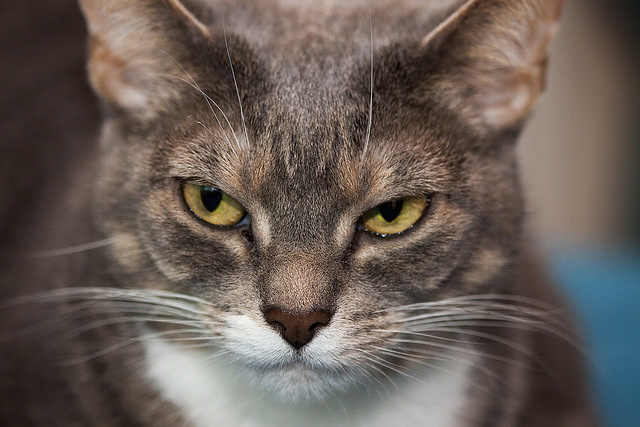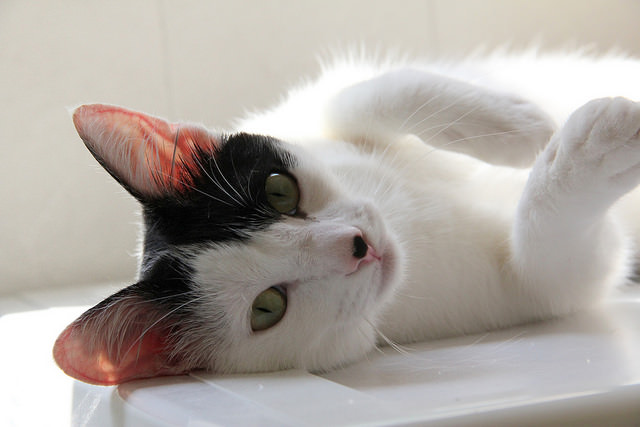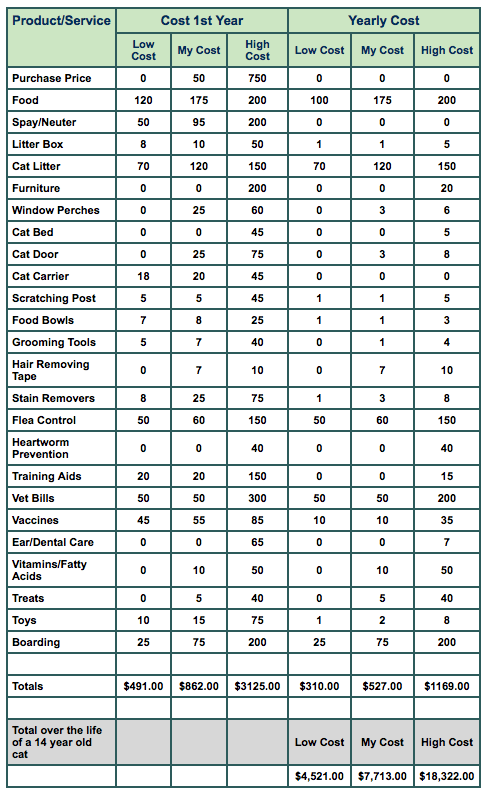If adopting a cat didn’t cost us anything, we’d probably all have 200. There are a lot of costs associated with bringing a cat into your life and home, and those expenses can add up to a pretty penny over the years. Taking the inevitable daily and occasional expenses into consideration before you adopt will help you ensure that you can give the best care to your new feline friend for as long as you are blessed to have her in your life.

Image Source: Ryan via Flickr.com
Initial costs
Many of these initial costs may be irrelevant, depending on where your cat comes from. Many shelters, for instance, will make sure their cats are spayed/neutered and vaccinated before becoming available for adoption.
- Adoption fees – Most shelters and rescue organizations charge an adoption fee. It takes a lot of money to run an organization that rescues and cares for animals and many of them heavily depend on these fees and donations to keep doing the important work they do. If the cat you’re adopting has had medical care, vaccines, or has been spayed/neutered while in the shelter’s care the fee will help cover those costs as well. If the fee is prohibitive to you, keep an eye out for free or reduced fee adoption days– many organizations hold these events several times a year.
- Spaying or neutering – Most shelters will make sure their cats are spayed or neutered before becoming available for adoption. If not, this cost will fall on you. Spaying or neutering is a great idea, even if your cat lives indoors with no chance for reproduction, since it greatly reduces territorial problems like urine spraying and health problems like certain types of cancer. Visit the Spay USA website to search your area for clinics that’ll spay and neuter for reduced prices.

Image Source: jeimey31 via Flickr.com
- Vaccinations – Many shelters will vaccinate their cats before making them available for adoption, but you will be responsible for keeping up with a routine vaccination schedule. Talk to your veterinarian about which vaccines are recommended for your cat.
- Home set-up necessities – There are some core supplies you’ll need before bringing your new cat home. If you’re not sure of what’ll be necessary right away, read our article Adopting Your First Cat? Stock Up On The Essentials First!

Image Source: Houser Wolf via Flickr.com
Ongoing basic costs
These are the costs most people associate with adopting a cat. Still, many people underestimate how quickly these costs add up over the course of a year.
- Food – Are you planning to feed dry food exclusively or will you incorporate some wet? Is organic or natural food important to you? Does your new cat require a special diet or is she finicky? The cost of food varies greatly depending on these factors.
- Litter – The cost of litter also appears to vary greatly, but it evens out a bit if you take into consideration how often you’ll need to completely empty and refill the box. Non-clumping clay litters are every inexpensive, but you’ll need to do a complete switch once per week. Clumping litters, by comparison, are more expensive initially, but you will only need to do a complete change once per month.
- Annual veterinary exam – Many people believe that their indoor cats don’t need to have annual exams, opting instead to only make appointments if something is wrong. The problem with this, of course, is that cats are masters at disguising pain and illnesses. We often have no idea anything is wrong until a problem has gotten out of control. Most injuries and illnesses are easiest to treat in the early stages.
- Toys, beds, etc. – It’s a mistake to think of toys as non-essentials. In order to stay physically and mentally active (and therefore as healthy as possible), cats need to have their prey instincts regularly stimulated by toys. Your home should also provide your cat with cozy places to nap, and a few perches from which she can observe her kingdom.

Image Source: Patricia Russano Cuyumjian via Flickr.com
Occasional costs
These are the costs that people often forget about when adopting a new cat. Some of them can be quite expensive, so it’s a good idea to take them into account before committing.
- Emergency/non-annual veterinary care – This is usually the most expensive part of adopting a cat. This includes any veterinary visits that happen outside of your cat’s regular annual exam and covers everything from examining a limp to diagnosing and treating a chronic illness.
- Flea and tick prevention – Unfortunately, even indoor cats can occasionally get fleas. Those tiny little things can slip in through the tiniest crevice of your home. Flea and tick prevention will be especially important, though, if you also live with a dog who spends time outdoors.
- Pet sitter/boarding – We all have to go away sometimes, whether for work or pleasure. When that happens, it’s our responsibility to make sure our animals are properly cared for in our absence.
An actual breakdown:
 via peteducation.com
via peteducation.com
Of course they are worth every single penny spent, because the lifetime of love and affection could never have a price tag when it comes to our feline companions.

